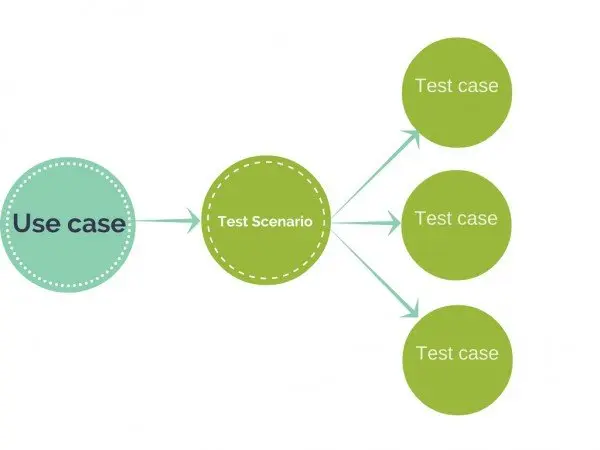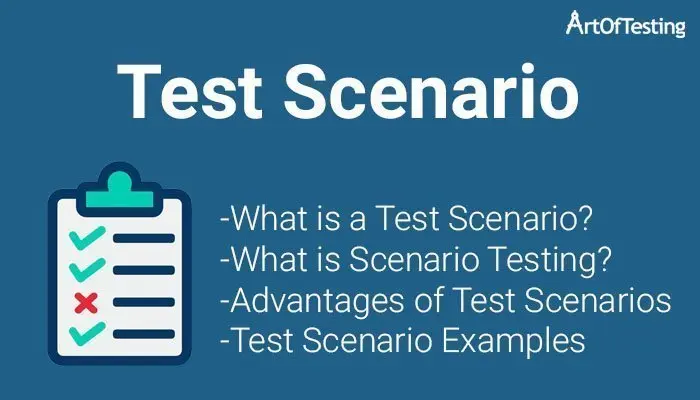In this tutorial, we will learn everything we need to know about test scenarios and scenario testing. Before starting with test scenarios and scenario testing, let’s first understand – what is a scenario?
A scenario is a credible and coherent story about how someone can use an application.
What is a Test Scenario?
A Test Scenario is a statement describing the functionality of the application to be tested. It is used for end-to-end testing of a feature and is generally derived from the use cases.
Test scenarios can serve as the basis for lower-level test case creation. A single test scenario can cover one or more test cases. Therefore a test scenario has a one-to-many relationship with the test cases.

As an example, consider a test scenario – “Verify that the user is not able to login with incorrect credentials”. Now, this test scenario can be further broken down into multiple test cases like-
- Checking that a user with the correct username and incorrect password should not be allowed to log in.
- Checking that a user with an incorrect username and correct password should not be allowed to log in.
- Verifying that users with incorrect usernames and incorrect passwords should not be allowed to log in.
Obviously, the test cases will have a well-defined format, explained in this post – Test case template.
Also, check – Difference b/w a test case and test scenario.
What is Scenario Testing?
Scenario testing is a type of testing carried out using scenarios derived from the use cases. Also, using scenario testing, complex application logic can be tested using easy-to-evaluate test scenarios.
Some characteristics of scenario testing are-
- Coherent – The test scenarios should be based on a coherent story about how the software application is used.
- Credible – They should be credible and focus on something that could happen in the real world.
- Motivating – They should motivate the stakeholders to get the issues fixed in case of the failed test scenario.
- Complex – The test scenarios normally involve a complex program or application flow.
- Easy to evaluate – The test result of the test scenario should be easy to evaluate, as it involves complex logic.
Advantages of Test Scenarios
- Faster Execution – Test scenarios can be executed more quickly than detailed test cases, making them ideal for agile or fast-paced development environments.
- Improved Test Coverage – Since test scenarios are derived directly from user stories or business use cases, they help ensure broader and more relevant test coverage.
- Time-Saving – Writing test scenarios requires less effort compared to creating step-by-step test cases, making them highly efficient for projects with tight deadlines or limited QA resources.
- High-Level Clarity – Test scenarios offer a high-level overview of what needs to be tested, which helps in aligning QA, development, and business teams on the expected functionality.
- Early Involvement of Stakeholders – Their simplicity makes it easier for non-technical stakeholders (like business analysts or product owners) to review and validate the test plan early in the SDLC.
Test Scenario Template
A Test Scenario document can have the below fields-
- Module – The module or the component of the application.
- RequirementId – This field is optional and can be linked to the SRS.
- TestScenarioId – This field is the identifier of the test scenarios.
- Description – The description field describes the purpose of the test scenario.

You can also download the test case template in the XLS file format below.
Best Practices for Writing Test Scenarios
- Keep It Simple and Clear – Write test scenarios in plain, concise language so they are easy to understand for all stakeholders, including non-technical team members.
- Ensure Easy Execution – Scenarios should be practical and executable without requiring excessive assumptions or preconditions.
- Maintain Accuracy – Each test scenario must reflect the exact functionality or user behavior it’s meant to validate—no guesswork, just precise intent.
- Ensure Traceability to Requirements – Map each test scenario directly to a corresponding requirement or user story. This helps in maintaining requirement coverage and supports impact analysis during changes.
- Avoid Ambiguity – The language used should be unambiguous, avoiding vague terms. This prevents misinterpretation and ensures consistent test results.
Test Scenario Examples
Below is the list of test scenarios that are frequently asked in software testing interviews. In these test scenario examples, we are covering scenarios related to UI, functionality, non-functional requirements, as well as negative test scenarios.
Although there can be numerous scenarios for any given application, we have limited the scenarios to the most basic and generic functionalities.
- Test Scenarios of ATM Machine
- Test Scenarios of Bike
- Test Scenarios of Calculator
- Test Scenarios of Car
- Test Scenarios of Chair
- Test Scenarios of Coffee Vending Machine
- Test Scenarios of DateField
- Test Scenarios of Door
- Test Scenarios of E-commerce Website
- Test Scenarios of Facebook
- Test Scenarios of Fan
- Test Scenarios of Flight Reservation System
- Test Scenarios of Gmail
- Test Scenarios of Google Search
- Test Scenarios of Hospital Management System
- Test Scenarios of Keyboard
- Test Scenarios of Kindle
- Test Scenarios of Lift
- Test Scenarios of Login Page
- Test Scenarios of Mobile Phone
- Test Scenarios of Mouse
- Test Scenarios of Microwave Oven
- Test Scenarios of Notepad
- Test Scenarios of Online Examination System
- Test Scenarios of Pen
- Test Scenarios of Pencil
- Test Scenarios of Registration Page
- Test Scenarios of Remote Control
- Test Scenarios of Stapler
- Test Scenarios of Table
- Test Scenarios of Triangle
- Test Scenarios of TV
- Test Scenarios of Wrist Watch
- Test Scenarios of Water Bottle
- Test Scenarios of Whatsapp
- Test Scenarios of White Board
- Test Scenarios of White Board Marker
- Test Scenarios of Youtube
Conclusion
I hope you now have a clear understanding of Test Scenarios. The example links given in this post will also help you understand scenario creation for different kinds of applications.


Hi kuldeep Rana,
It’s really good.
Please send me test cases for test share point application and Firefox browser application if you can.
It will be really appropriated.
hi shusma
please write some test cases on master card i need
Hi,
In which phase scenario test will take place.
when will they perform scenario testing.
We can do scenario testing as an alternative to testing using test cases. So, scenario testing can be performed when you execute test cases.
Hello there, You have done a great job. I will certainly digg it and personally suggest to my friends. I’m sure they’ll be benefited from this site.
need test case for alexa,wall,etc.
Very good content, thanks for this excellent write up !
sir test scenario and test cases are diffrent right bt in this you have given test scenario link bt it shows test cases …
The download link is on Test Scenario only. For test cases, you can refer to – http://artoftesting.com/test-case.
Test sceanadio of send a message
I need help with test case scenarios please.
Amazing post, thanks for this valuable content!
I was examining some of your articles on this site and I think this site is real instructive! Keep on posting.
Hi Kuldeep, Could you please add “Test Scenarios of Printer Machine”.
Integration scenarios for Facebook
Hi Kuldeep,
Please provide some test cases on static content of landing pages of any website, which includes pictures, written slogans and advertisements.
Thanks
very nice
Hi Kuldeep
It is rellay good and helpful testcase .Thank you so much for your efforts and guidance .
pls add whatsapp status test scenarios
Hello Kuldeep,
Test Scenario to login page on Third Party application like Myntra.(we get option like login with Facebook, Google, or Email) so if we login with google it will share our details but still we want to login to that site how can we login and what is the process. what are the scenarios for that process